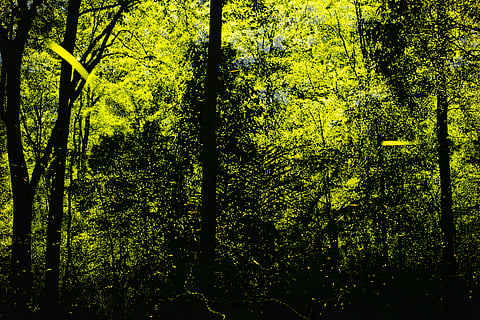

In October 2024, Chennai’s glowing sea drew thousands to the shore. For two nights, bioluminescence lit up the waves and the city’s imagination. Those brief, shining nights were a reminder of how stunning nature can be and how little of it we get to witness anymore. But not long ago, our parents saw bioluminescence often, as it flickered in the air, emitted by fireflies.
Headlines recently warned: ‘This could be the last generation to see fireflies.’ But is the situation truly as alarming as it seems? Sriram Murali, International Union for Conservations of Nature (IUCN) firefly specialist, who works closely with Aanamalai Tiger Reserve in Tamil Nadu, says it’s not.
“Many others and I, who are documenting fireflies across the world, are still finding them in large numbers; from cities like New York in the USA to Bengaluru in India. These recent reports are gravely exaggerating,” he says. Sriram notes that fireflies are abundant in Karnataka, Kerala, and Tamil Nadu — often spotted in the peripheries of cities, and in the fringes of forests. At the Aanamalai Tiger Reserve, a firefly hotspot, these flickering wanderers even put up light shows, in 2022, which he documented.
While the situation may not be dire enough to signal extinction just yet, multiple factors do threaten their numbers. “Rains are important for fireflies to survive because they increase the moisture in the soil and create ideal conditions for reproduction. Due to climate change-led sporadic rainfall patterns in India, fireflies’ numbers get negatively impacted,” Sriram says. Fireflies were spotted in large numbers in 2022, because of abundant rainfall, but the numbers were low in 2023 and 2024, he notes. “This year, there’s an excellent increase in the number of fireflies,” he adds.
In cities like Chennai, meanwhile, fireflies are steadily losing their habitats — green spaces, wetlands, and waterbodies — to concrete structures. The urban sprawl also disrupts fireflies’ communication because of light pollution.
Sriram also notes that even the hotspots, away from the cities, are now beginning to face a quiet threat, as lights from packed cities leak into dark and dense forests. “This is something we are recently noticing. Especially lights and sound from destination weddings being held in the open, are spilling into forests and tiger reserves,” he informs.
To control this issue, he calls individuals and local governments to action. People should opt for orange or yellow lights because they don’t travel distance like white lights do, he says, adding that lights should be shielded and pointed to wherever required. “If you are lighting up your balconies, or your terraces, try to follow these steps, or its best to turn them off at night,” he recommends. Governments and corporations alike should opt for streetlights that have a colour temperature of 2,700 kelvin or less, he notes.
“This way, we humans — newcomers to the planet at just 300 thousand years old — can make space for these ancient insects, who’ve been around for over 300 million years. Their cold light is one of nature’s most beautiful wonders and is truly worth preserving,” he concludes.
Light Lessons
Fireflies emit light from their lower abdomen region, where luciferin, a light-emitting compound and luciferase, an enzyme that triggers the reaction, come together. They can control this light, to either communicate, attract mates, or to warn predators.